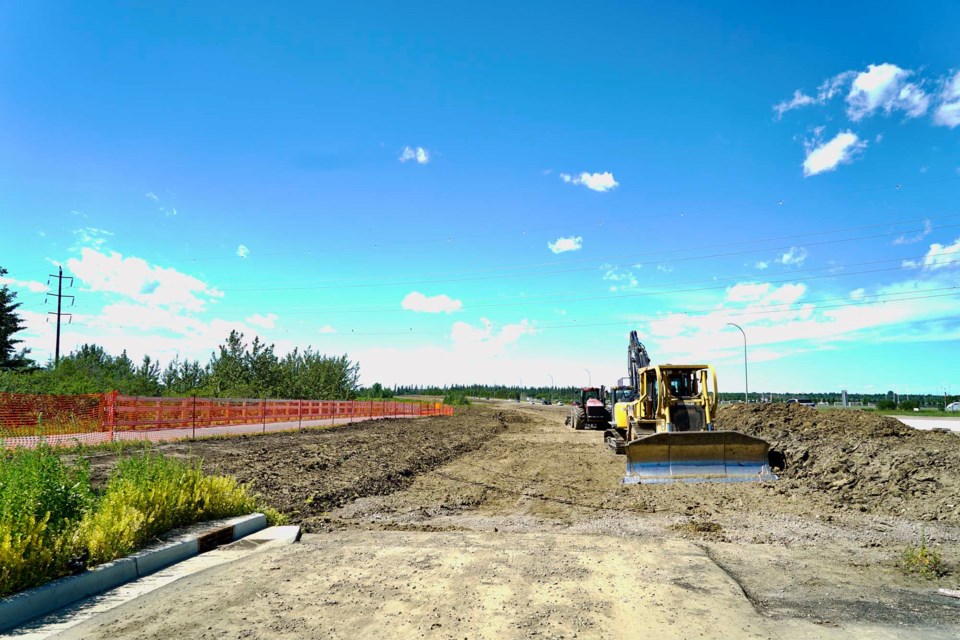St. Albert has begun phase two of the Ray Gibbon Drive twinning project that will ultimately transform the undivided two-lane roadway from 137th Avenue to Villeneuve Road into a four-lane arterial roadway.
Phase one of construction spanned from the south city limit up to north of the LeClair way intersection. The second phase will focus on the corridor from north of LeClair Way to north of McKenney Avenue, and is looking to wrap up Oct. 22. In this phase, a new bridge will be installed over the Sturgeon River adjacent to the existing bridge.
The cost of this portion of the project is currently evaluated at $12.5 million.
Coun. Natalie Joly, acting as deputy mayor, said the twinning of the road has been a priority for council for as long as she can remember.
"To see work moving forward is really a testament to the focus of the council and our administration in supporting the goal of continuing work on that transportation corridor," Joly said.
The bridge will not require in-water work, due to pre-existing piers that were constructed between 2006-07. However, construction workers will create abutment seats, the flat part of the bridge's supports that reduces the stress on the bridge. This process will require excavation on the banks of the Sturgeon River.
Tony Druett, a board member of the Big Lake Environment Support Society (BLESS), a nonprofit that aims to conserve the Big Lake wetlands, said that this phase of the twinning is the "most critical section" of the project from the group's perspective.
"It's an area where there are migrations and movements of wildlife," Druett said. "Coyotes, deer, and various animals actually have a mobility route across there, so it's of great concern to BLESS that the widening of the road is done in an environmentally sensitive way that takes this into account."
With this in mind, Druett said BLESS's discussion with the city on major concerns surrounding this phase of the project have not gone unaddressed.
One concern BLESS initially had about this phase of construction surrounded a multi-use trail on the west side of the road north of Sturgeon River. In the first phase of construction, multi-use trails for bicycles had been added on both sides of the road leading up to the city limit, but BLESS was worried about the impact one of those trails could have on the shoreline of Big Lake and Ray Gibbon Drive.
"That land is a very sensitive environmental area," Druett said. "That's where all the migrating birds nest, so we don't want there to be lots of people tromping all over the area."
Druett added that while this area should not be closed to the public, BLESS anticipated the addition of a trail would bring too much foot-traffic into the area. Now, the city states on its website there will only be a multi-use trail on the east side of the road, but not the north.
BLESS was also concerned about the portion of Red Willow Trail that runs underneath the Ray Gibbon Drive bridge, which had been subjected to severe flooding in previous years. Druett said BLESS had asked if the city would consider raising the trail to minimize the amount of the flooding each year, an item the city has now agreed to.
Additionally, BLESS had asked the city if the north side of the river under the Ray Gibbon Drive bridge will be enhanced to function as a wildlife corridor to provide a safe crossing route for moose and other animals that are migrating along the river to have a way of crossing Ray Gibbon Drive.
"I think if we hadn't brought this up, it's quite possible that another multi-use trail would have been built on the north side of the river, rather than leaving space to funnel the animals under the bridge," Druett said.
Joly said the input from BLESS on the project has been "invaluable."
"They're a very important partner for environmental concerns in St. Albert, and making sure that the wildlife that use that corridor are protected," Joly said.
Druett said one aspect of the construction BLESS will be mindful of going forward is how fencing surrounding the road might impact wildlife. In phase one of the twinning, Druett noted some sections of the road included fencing, while some did not.
He said fencing to prevent wildlife from running across the road can lead to issues if there are not enough tunnels underneath the road or overpasses for the animals to use as a mobility route instead.
"BLESS doesn't have a concrete position on whether or not there should be fencing, but it's definitely a very difficult issue that needs to be well considered," Druett said.



